All published articles of this journal are available on ScienceDirect.
A Review on the Recent Flavoring Herbal Medicines of Today
Abstract
Background:
Herbs are the most trending taste enhancers, carrying multiple benefits. Sprinkling them in minute amounts in pasta, salads, sautéed vegetables, curries, fried rice or adding them in dips and sauces can lead to enhanced flavours. The fresh and dried versions serve the same purpose, especially when the fresh ones are not available.
Objective:
The objective of this article is to explore and review trending flavouring herbs of the present era with reference to the knowledge available from previous texts.
Materials and Methods:
A literature review has been performed on various herbs such as dill, cilantro, parsley, chives, mint, oregano, etc, which can be used as healthy and taste enhancing sprinklers and garnishers for foods.
Results:
There are various herbs present in nature in many forms and patterns, some provide anti-inflammatory benefits, are anti-microbial and most of them are digestive in nature.
Conclusion:
These herbs are very rich in phytoconstituents, having multiple properties like anti-oxidant and carminative effects. They are superior as compared to artificial additives as well.
1. INTRODUCTION
Herbs and spices serve both for culinary and medicinal purposes for ages. They provide multiple uses in addition to enhancing the flavor of foods and desserts. The nutritional contribution of these dietary important herbs is negligible due to their small amounts consumed [1-4]. Herbs are mainly leafy and green belongings of the non-woody plants found in the temperate zone. While fresh, herbs have more aroma, but spices are mostly more useful in dried powder form. Sometimes both herbs and spices are obtained from the same plant. The seeds from the dill plant are used as spices, while the stalk of the plant is a herb [5-9]. Spices have been used for not only flavour and aroma of the foods but also provide antimicrobial properties. Spices including Clove or Eugenia caryophyllus, Cinnamon in the form of Cinnamomum zeylancium, Black pepper or Piper nigrum, Turmeric as Curcuma longa and Ajwain or Trachyspermum ammi are very effective as anti-bacterials. Spices have been recognized for their value of preserving foods and medicinal values due to richness in bioactive antimicrobial compounds [10-13]. The present review is based on the trending herbs being used as flavour enhancers, along with the health benefits offered by them in the present era.
2. MATERIALS AND METHODS
A literature review was performed to pertain to the information about herbs used as flavour enhancers, carminatives etc. The search was done on Google scholar, Pubmed, MEDSCAPE, Scopus, BMC, Science Direct, MEDLINE database, SCOPEMED and other databases, using keywords like flavour, herbs, foods, phytoconstituents. etc. The information was also extracted from various books of Pharmacognosy available in the Library of Pranveer Singh Institute of Technology, Kanpur, NBRI Lucknow. Available dissertations/thesis and various research articles were also investigated.
3. CURRENT SCENARIO OF FLAVOURING HERBS
The flavor market is still developing and offers multiple benefits for novices to flourish in this market. Additional factors such as awareness among users, present specific health and nutritional needs are strongly beneficiating the food and beverage sector, which, in turn, are promoting the over all market. There is a huge demand for new varieties, mainly in the health foods and beverages, a trend which is expected to continue in the future. Examples of phyto constituents, from Apiaceae family are coumarins and flavonoids compounds like psoralen, 5-methoxypsoralen, 8-methoxypsoralen and apigenin that could inhibit CYP1A2-mediated activation of carcinogens. Anethole is a key phenolic compound in volatile oil of anise and an estrogen receptor and could inhibit cell survival. Herbs, spices and seasonings play an important role in reducing sodium and even sugar in processed products. Formulators are substituting salt in foods with acidic lemon juice, vinegar, herbs, spices and seasoning blends. Some of the best flavorful herbs used to replace sodium would be basil, rosemary, thyme, cilantro etc.
The main herbs discussed in this paper are illustrated in Table 1.
| S.No | Herb | Botanical Name | Form Used | Health Benefits |
|---|---|---|---|---|
| 1. | Basil | Ocimum sanctum | leaves | Immunity-booster |
| 2. | Parsley | Petroselinum crispum | leaves | Anti-oxidant |
| 3. | Oregano | Origanum vulgare | Leaves and flowers | Anti-microbial |
| 4. | Thyme | Thymus vulgaris | Oil from flowers | Carminative |
| 5. | Dill | Anethum graveolens L. | Seeds and leaves | Digestive |
| 6. | Cilantro | Coriandrum sativum L. | Leaves and stems | Anti-flatulence |
| 7. | Chives | Allium schoenoprasum L | leaves | Anti-oxidant |
| 8. | Mint | Mentha piperata | leaves | Coolant |
3.1. Basil (Tulsi)
Holy basil as shown in Fig. (1) can inhibit the growth of a range of microbes [14]. One small study highlighted that it can enhance the functioning of the immune system by increasing the number of certain immune cells in the blood. Holy basil also reduces blood sugar levels before and after meals, as well as, is used for treating anxiety and anxiety-related depression. It is also an antioxidant, which inhibits lipid peroxidation and decreases inflammation. There are different types of basil, which are different in taste and smell. Sweet basil, because of its high concentration of eugenol, is the most commercially available basil used in Italian food. Alternatively, lime and lemon basil have a strong citrus scent due to their high concentration of limonene. Basil is rich in essential oils, phenolic compounds and a wide variety of other natural products as polyphenols like flavonoids and anthocyanins. It has multiple culinary applications in baking, beverages and ice cream. Extract from pure Basil can also be used in butter cream, lemon, strawberry, coffee or chocolate flavored cakes [15-18].
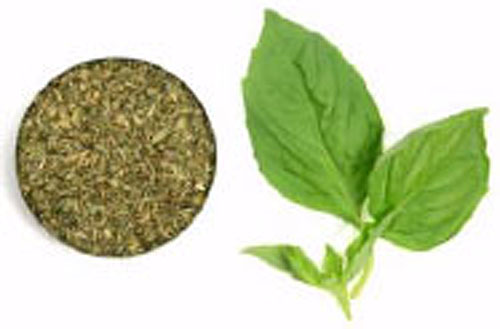
3.2. Parsley
Parsley is used as a garnish for adding finishing touches to a dish or cuisine. It imparts freshness and brightness of colour. Parsley as shown in Fig. (2), belongs to the family of Apiaceae, making it relatable to other herbs such as carrot, cumin and dill [19]. It is a source of flavonoid and antioxidants, especially luteolin, folic acid, vitamin K, C and A. Half a tablespoon of dried parsley is rich in 6.0 µg of lycopene and 10.7 µg of alpha carotene, along with 82.9 µg of lutein and zeaxanthin and 80.7 µg of beta carotene. While flat parsley is primarily useful in seasoning purposes as it imparts robust taste such baking it into a meatloaf or bread. It has a sweet and tender flavour which is closer along the lines of a carrot. Excessive consumption of parsley is not preferable for pregnant women. It is safe in normal quantities, but large amounts may have uterotonic effects.2-6 leaves also are used as a food flavor and for gastrointestinal disorders [20-22].
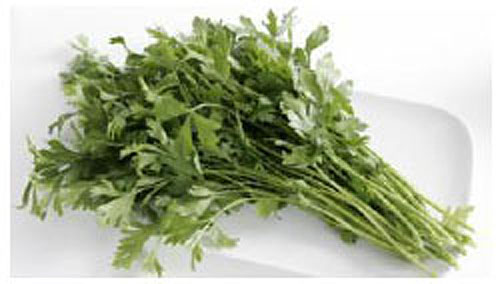
3.3. Oregano
Also called as Ajwain leaves, belong to O. vulgare subspecies hirtum, which has a spicy flavor. This subspecies carry furry leaves and floppy white flowers. Mexican oregano has the same properties but comes from a different plant, Lippia graveolens Kunth, better used as an antioxidant and antimicrobial. Origanum vulgare, a member of the plant family Lamiaceae is generally the spice variety sold as oregano in Europe and the United States. Its light green leaves are used in either dry or fresh form in the form of culinary seasoning. Two constituents of oregano, such as carvacrol and thymol are very important as there are so many species of Origanum, used as condiment and for medicinal purposes. There are variations in the profiles of bioactive constituents and in the expected beneficial effects. [23-28]
3.4. Thyme
Also known as Ajwain ke Phool, provides the essential oil of common thyme or Thymus vulgaris, containing 20 - 54% thymol. Thyme essential oil also contains terpenes such as p-cymene, myrcene, borneol and linalool. It is used in meat or vegetable, fish, beans, pizza, stuffings, fish sauces, cheese and egg dishes. The flavor and smell of thyme as shown in Fig. (3), enhances the cuisine it is used in and gives dishes a delicacy that is incomparable [29]. However, it is essential that the herb is used in the proper way to provide the best of its advantage. Fresh thyme has a pronounced, concentrated herbal flavor with sharp floral notes [30-33].
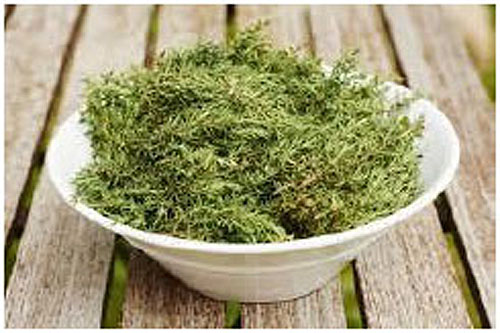
3.5. Dill
Anethum graveolens L. as shown in Fig. (4), is the only species of the genus Anethum, though classified in the related genus Peucedanum as Peucedanum graveolens [34]. Anethum seeds are used as a spice and its fresh and dried leaves are used as condiment. The aromatic herb is commonly used for flavoring and seasoning of various foods such as pickles, salads, sauces and soups. Fresh or dried leaves are used for meats, fish, sandwiches and fish sauces. It is also an essential ingredient of sour vinegar. Dill oil is obtained from seeds, leaves and stems, which contains essential oil, which is used as a flavoring agent in the food industry. Fresh dill is often added to seafood, yogurt sauces, vinegar, potato salads, fresh-baked breads and soups and it can also be used as a garnisher like parsley [35-40].
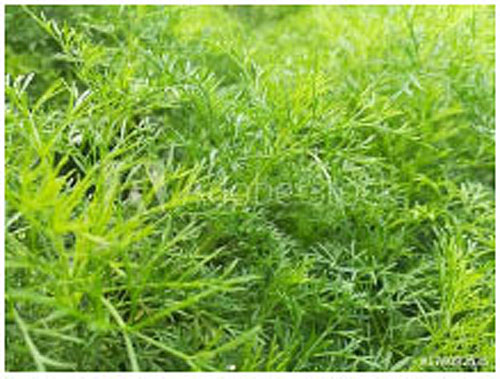
3.6. Cilantro
or Coriandrum sativum Linn. has many medicinal properties. It refers to the leaves and stems of the coriander plant. Cilantro as in Fig. (5), has a very different flavor as quite pungent [41]. It provides good taste to spicy foods.The green leaves of coriander are known as “asotu” in the Eastern Anatolian region or “cilantro” consumed as a fresh herb. Coriander seed oil contains linalool (60-70%) and 20% hydrocarbons and the composition of the herb oil completely differs from the seed oil. The essential oil of ripe and a dried fruit of coriander varies between 0.03 and 2.6%, and the content of fatty oil varies between 9.9 and 27.7%. Dried coriander seeds contain essential oil (0.03-2.6%) with linalool as the main component. Other components of the essential oil are: α-thujene, sabinene, β-pinene, myrcene, p-vymene, limonene, z-β-ocimene, y-terpenin, terpinolene, camphor, citronellal, trpinene-4-ol, decanal. Cumin aldehyde and geranyl acetate [42-45].
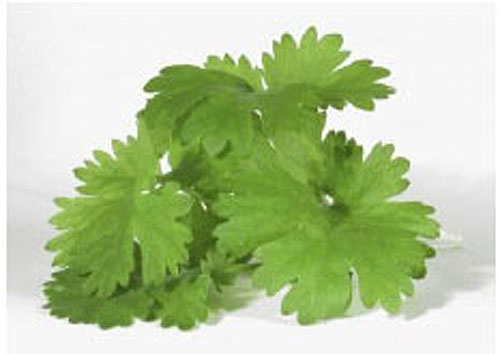
3.7. Chives
Allium schoenoprasum L. is native to the cooler regions of Europe and Asia. Cultivated by gardeners since the Middle Ages, it is now is available at home any-where. Chives, as shown in Fig. (6),is used for garnishing, in salads, mayonnaise, vegetable, soups, creamy sauces, adding the herb to the dish just before serving [46]. Purple-blue chive flowers are also used as a garnishers. The main polyphenolic constituents of its leaves are p-coumaric acid, ferulic acid, isoquercitrin and rutin. It is also rich in malonic diesters of cyanidin 3-glicoside, 3-sophoroside-7-glucosiduronic acid or kaempferol [47-49]. This member of the onion family, is widely used as a culinary herb to provide mild onion flavour to many foods like salads, soups, vegetables and sauces. Chive has green leaves and pale purple edible flowers. The plant is used in traditional folk medicine as digestive, anti-anaemic, enhances the immune system and also acts as a blood cleanser. Recent studies have reflected the antioxidant properties of the bulb, leaf and stalk of plant as shown in Fig. (6) [50-53].
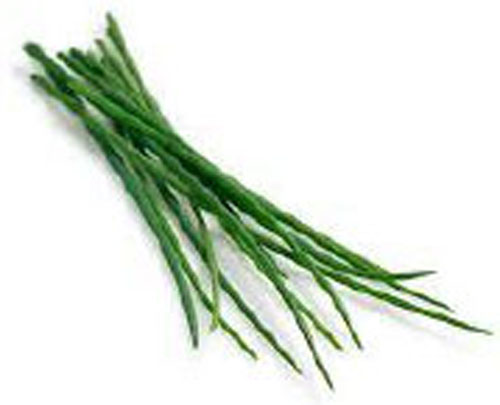
3.8. Mint
Allium schoenoprasum L. Mint is a herb as in Fig. (7), which is used for its antispasmodic, analgesic, anti-inflammatory, antispasmodic, decongestant effects [54]. Peppermint is one of the mentha species, which is mentha piperita, mentha arvensis etc. Menthol and menthone are the major constituents of the peppermint essential oil [55-59]. Peppermint is used for the treatment of dyspepsia without any known side effects. It improves the gastric emptying rate. Ancient Greek, Roman, and Egyptian cultures have been using the herb in cooking as well as in medicine [60-65].
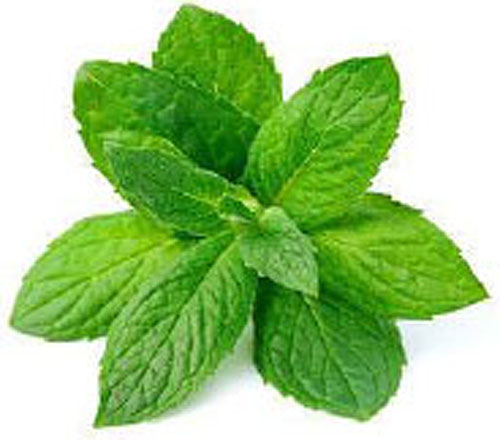
4. FUTURE PROSPECTS OF FLAVOURING HERBS
The future of the Indian flavors market is based on the launch of novel foods and beverages containing health and functional ingredients. Innovation in flavor variants of major resources, elevation of sales force potential and technological refinement are the main factors for the success of a flavor industry. The addition of herbs, spices, and botanicals to food and beverages enhances flavor, helps replace sodium, sugar, artificial colors and flavors and solves some health issues. Every year, trendy new combinations of spices and herbs come in the limelight. Cardamom, hatch chile, doenjang and turmeric are gaining interest in the supermarkets today, as are green and herbal, hot and spicy and even floral flavors. People want as authentic and traditional a flavor as possible. Latin American flavors include garlic and onion, cumin and coriander, or strong herbal flavors of parsley and cilantro in the form of chimichurri. The use of ethnic condiments will continue to grow with the great demand from millennials, who always want something new.
CONCLUSION
The main health benefits of culinary herbs and spices are because of the presence of polyphenols. They add flavors to the cuisine and give dishes a delicacy that is incomparable with any other herb. It is necessary to use the proper part of the herb in a proper way for its best advantage. It is effective to treat dyspepsia without any side effects. It helps in the gastric emptying rate. It enhances the flavor of seafood, yogurt, sauces, vinegar, salads, breads and soups and it can also be used as a garnish like parsley. They are rich in dietary polyphenols, known for reducing the risk of developing chronic non-communicable diseases. However, normally in small quantities and in combination with other foods, they are used. They offer a wide range of essential oils, phenolic compounds as flavonoids and anthocyanins. They have a wide variety of applications in baking, beverages and ice cream.
CONSENT FOR PUBLICATION
Not applicable.
FUNDING
None.
CONFLICT OF INTEREST
The authors declare no conflict of interest, financial or otherwise.
ACKNOWLEDGEMENTS
Declared none.


